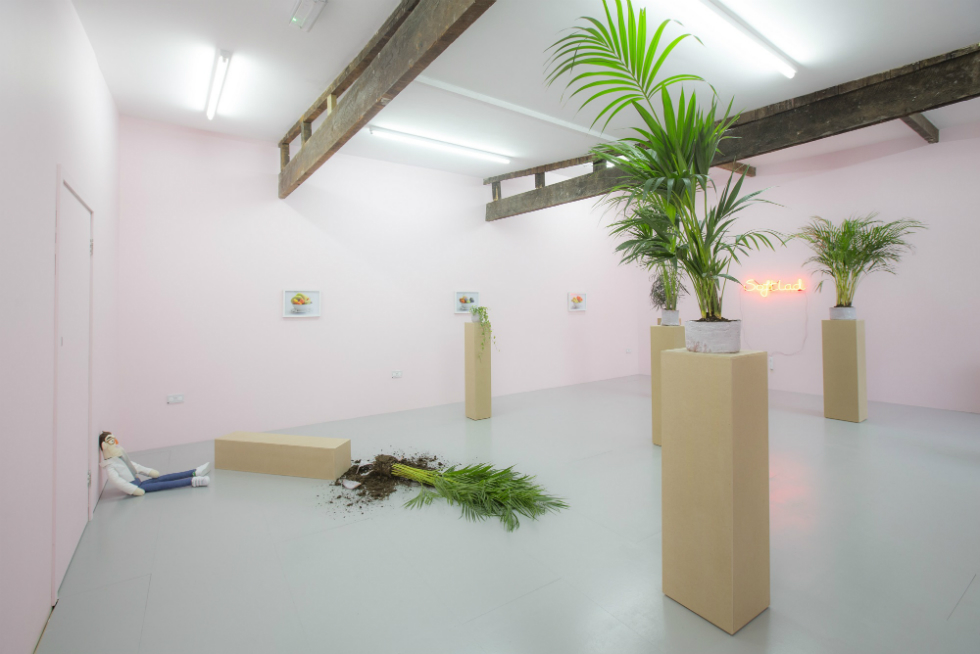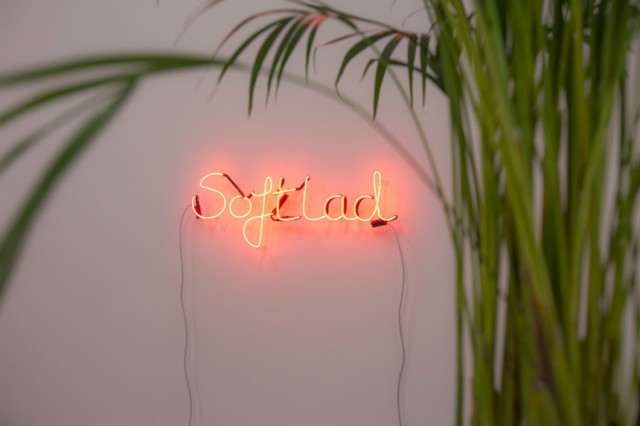“Both tongue-in-cheek and trite”: Joe Fletcher Orr / Mummy’s Boy — Reviewed

What is an artistic collaborator? Is it someone who decided to “reach out” after scanning your Instagram feed, or can it be someone who has known you since you were born? Orla Foster ponders the art of parental guidance at The International 3 gallery…
For Mummy’s Boy, his second solo show in collaboration with The International 3 (Salford), Joe Fletcher Orr takes a wry look at the mother/son relationship. It’s an exhibition in which his mother appears not only as inspiration, but also as an accomplice and collaborator.
Fletcher Orr recognises, of course, the absurdity of positioning himself as a naïve child within his own work. This self-awareness is right there in the title, setting the tone for an exhibition which see-saws somewhere between mockery and affection. He isn’t afraid to appear sentimental, either, as can be gauged from Friendly Name For A Fool (2016), a sign spelling out the words Soft Lad in garish, neon letters. It’s as though he wants to beat the viewer to the punchline, to be both tongue-in-cheek and trite.
Perhaps the most immediately eye-catching work here is Happy Pot (2016); four house plants which are arranged on columns throughout the space, lending it the atmosphere of a well-tended living room. The pots themselves were made by the artist and his mother at a ceramics workshop; as if the creative process were after all a therapeutic family pastime rather than an internal agonising struggle. That feels groundbreaking in itself. Also, plants — both a symbol of growth and a well-managed household — are suggestive of the nurturing role of family. Artists are meant to Explore and Investigate and Interrogate, aren’t they? Not just… be nurtured.
We’ve seen this playful approach in Fletcher Orr’s work before; for example, Orranorco (2014), in which he decided to exhibit his dad’s idea of the “perfect” rug. When the rug failed to ship on time, however, a stand-in was displayed in its place. Ultimately, the viewer didn’t need to see the original object but instead was expected to take the artist’s word for it that it represented something special, making the substitute item a sort of tribute to his father’s good judgment.
This idea of parental wisdom runs through Mummy’s Boy. We are led to picture the relationship, the conversations and the decision-making of mother and son in every, small detail. The colour of the walls, for example, is categorised as a work in itself: Strawberry Surprise (2016). The shade was selected by the artist’s mother, perhaps in an echo of childhood visits to Rapid or B&Q to weigh up swatches for the bathroom or kitchen. Yet even to make this kind of observation feels lazy and speculative on the viewer’s part, as though the creative scope of parents was strictly limited to DIY on bank holidays. If we are interested in what the artist has to say, then why not in his parents? Are their creative decisions somehow less deserving of a platform?

Similar concerns are raised by the still life photographs, Welcome Fruit, I, II and II (2016); three studio shots of a bowl of fruit, tastefully arranged by the artist’s mother. With glossy oranges poking out of their red netting, Fyffes bananas and conference pears, the softly-lit compositions somehow exude a sober gravitas even while showcasing the most familiar and domestic of objects. The resulting images seem archetypal both in the home and the history of art.
But it’s not possible to write such a grandiose statement without wanting to laugh and then look at the works again from scratch. More questions arise. What is an artistic collaborator, anyway? Is it someone who decided to “reach out” after scanning your Instagram feed, or can it be someone who has known you since you were born? Does creating meaningful work need to involve a tortured internal conflict, or simply picking out a can of Dulux? Have we all missed a trick not teaming up with our folks?
Finally, for the piece Muppet (2016), Fletcher Orr enlists a surrogate, or doppelgänger, in the form of a large rag doll propped up against one of the walls. Wearing jeans and trainers, with thick-rimmed glasses stitched onto its felt face, the doll was ordered from a site which specialises in creating the customer’s likeness out of photographs — the ultimate personalised toy. Close by is Sad Pot (2016), a companion piece to Happy Pot (2016), the difference being that this pot is now reduced to shards of clay, the column flat on the ground and surrounded by soil. It’s as if the viewer has arrived moments after the doll has toppled the display — just in time to catch it sitting back and beaming innocently at the surrounding chaos.
Yet this moment of disruption is also carefully choreographed; a nod to childhood whereby even an act of sabotage amounts to little more than a cheeky mishap. The invisible third party, you imagine, is the beleaguered mother realising that she has to drag the hoover out again. But this, too, is pure speculation. Maybe this exhibition isn’t trying to Make A Statement, but really is just a warm observation of family life, and its relationship with artistic practice.
Mummy’s Boy is a show which pretends to be insipid, with its pastel colours and fruit bowls, but does so with a lightness of touch that makes the whole concept really quite entertaining. Fletcher Orr draws parallels between the idea of a solo exhibition and that of a Year 5 project ready to be unveiled to waiting classmates. It’s as though the artist is playing with our assumptions of artistic agency and taking them down a peg or two: this show is subversive precisely because it appears not to be. Somewhere, just out of shot, the artist has pushed over a house plant and is laughing while we hypothesise over the wreckage.
Orla Foster
This article has been commissioned by the Contemporary Visual Arts Network North-West (CVAN NW), as part of a regional critical writing development programme funded by Arts Council England — see more here #writecritical
See Joe Fletcher Orr / Mummy’s Boy at The International 3 gallery, Salford, Greater Manchester, from Wednesday 23 March until Friday 29 April 2016
Gallery open Weds-Fri 12pm-5pm (other times by appointment)





